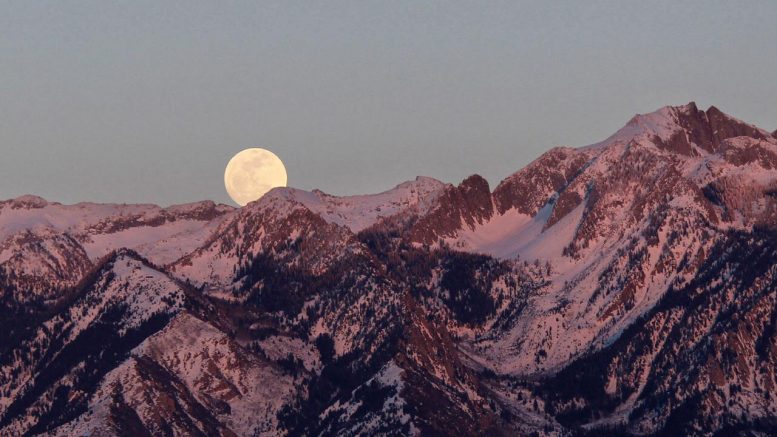
In February, the indigenous tribes of the present-day northeastern United States referred to the full Moon as either the Snow Moon or the Storm Moon. Credit: NASA/Bill Dunford
The Next Full Moon is the Snow, Storm, and Hunger Moon; the Moon of the Purim Holiday; the Chinese Lantern Festival; Magha Purnima and the Kumbh Mela Pilgrimage to Haridwar; and Māgha Pūjā.
The next full Moon will be early Saturday morning, February 27, 2021, appearing opposite the Sun in Earth-based longitude at 3:17 AM EST. This will be on Friday night from Alaska’s timezone westward to the International Date Line. The Moon will appear full for about three days around this time, from Thursday night through Sunday morning.
In the 1930’s the Maine Farmer’s Almanac began publishing “Indian” Moon names for each month of the year. These names have become popular and widely known. According to this almanac, as the full Moon in February, the tribes of what is now the northeastern United States called this the Snow Moon or the Storm Moon because of the heavy snows that fall in this season. The last time I checked (which was several years ago), NOAA long-term monthly averages for the Washington, DC area showed January and February were nearly tied as the snowiest months of the year. Bad weather and heavy snowstorms made hunting difficult, so this Moon was also called the Hunger Moon. Across North America, there are many different Native American names for the full Moons.
Sunset on Thursday, February 25 to nightfall on Friday, February 26, 2021, will be the Purim holiday in the Hebrew calendar. Purim is celebrated on the 14th day of Adar in the Hebrew calendar (or on the 15th in Jerusalem and ancient walled cities). This means it occurs just before the full Moon in Adar. Purim marks the Jewish people’s deliverance from a royal death decree around the fourth century BCE, as told in the Book of Esther and is celebrated by exchanging gifts of food and drink, feasting, and donating to charity.
February 26, 2021, will be the Chinese Lantern Festival. This is the traditional end of the Chinese New Year celebrations and is held on the 15th day of the first month of the Chinese Calendar.
In the Purnimanta tradition that ends the months on the full Moon day, this full Moon (purnima) is Magha Purnima, the last day of the month of Magha. In the Hindu and Buddhist calendars, Magha is the lunar month when the full Moon is in the lunar mansion that contains the star we call Regulus. For Hindus, Magha is a month for austerity, performing acts of charity, and ritual bathing at the confluence of three rivers (triveni sangam) and other holy riverside locations. At four of these locations major pilgrimages and festivals are sometimes held based on the position of the Sun, Moon, and the planet Jupiter in different zodiac constellations. Some versions of Hindu legend say that drops from a pot of the nectar of immortality spilled onto Earth at these locations. The name for these festivals, Kumbh Mela, comes from the Sanskrit words for “pitcher” or “pot” and the words for “meet” or “assemble.” This year (2021) will be the Kumbh Mela at Haridwar, a holy site where the river Ganges leaves the foothills of the Himalayas and enters the Indo-Gangetic Plain. There are strict COVID-19 guidelines in place at Haridwar for the safety of the pilgrims.
For Buddhists, this full Moon corresponds with Māgha Pūjā, the second-most important festival of the year. Māgha Pūjā is celebrated on the full Moon day of the third lunar month in Cambodia, Laos, Thailand, and Sri Lanka; and on the full Moon day of Tabaung in Myanmar. It celebrates a gathering of the Buddha with 1,250 of his first disciples, which, according to tradition, preceded the custom of periodic recitation of discipline by monks. On the day, Buddhists celebrate the creation of an ideal and exemplary community, which is why it is sometimes called Saṅgha Day, Saṅgha referring to the Buddhist community. In Thailand, the Pāli term Māgha-pūraṇamī is also used for the celebration. Some authors referred to this day as the Buddhist All Saints Day. In Sri Lanka, Māgha Pūjā is also observed with a procession of approximately 5,000 people and many elephants, called Gangarama Navam.
In most lunar and lunisolar calendars the months change with the new Moon and full Moons fall in the middle of the lunar month. This full Moon is the middle of the first month of the Chinese calendar, Adar in the Hebrew calendar, and Rajab in the Islamic calendar. Rajab is one of the four sacred months in which warfare and fighting are forbidden.
As usual, the wearing of suitably celebratory celestial attire is encouraged in honor of the full Moon. Stay warm; watch out for snowstorms; avoid starting wars; do what you can to reduce hunger including gifts of food and other acts of charity; and when the weather is clear take advantage of these early nightfalls to get out, look up, and share the wonders of the sky!









Be the first to comment on "Don’t Miss the Next Full Moon – The Snow, Storm, and Hunger Moon"